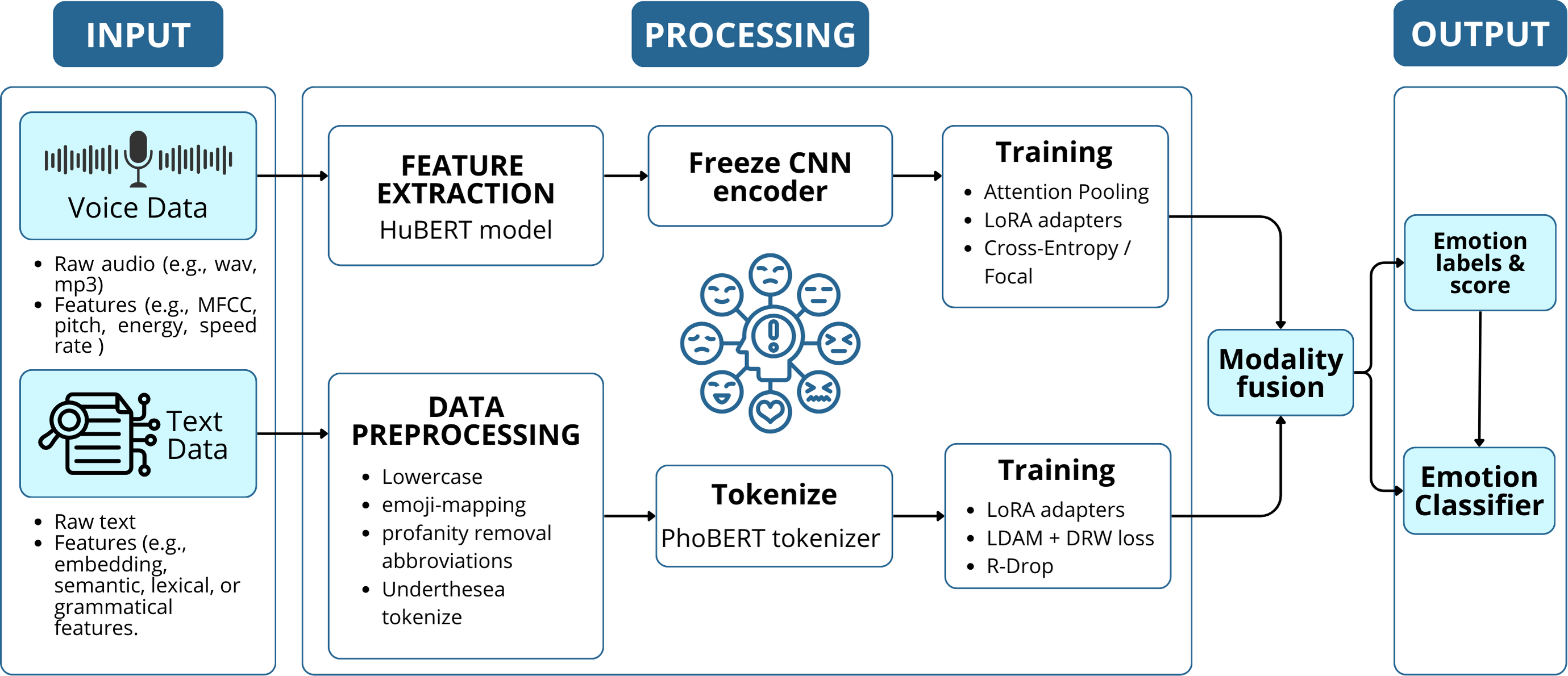Explore Our Projects
- AI
Vietnamese Emotion Recognition from Voice and Text: A Confidence-Based Approach
Giải pháp gộp đa phương thức dựa độ tin cậy kết hợp HuBERT và PhoBERT-v2 giúp nhận diện cảm xúc tiếng Việt chính xác, nhanh, nhẹ, sẵn sàng cho ứng dụng thời gian thực và thiết bị hạn chế tài nguyên.
- AIoT
TactiWave: Thiết bị giao tiếp xúc giác hỗ trợ người khiếm thính - khiếm thị
TactiWave là một công nghệ hỗ trợ sáng tạo được thiết kế để giúp đỡ những người bị khiếm thính và khiếm thị. Sử dụng bảng chữ cái Lorm, TactiWave chuyển đổi ngôn ngữ nói thành rung động xúc giác, giúp người dùng có thể nhận và hiểu thông tin thông qua cảm giác chạm. Thiết bị tích hợp công nghệ nhận dạng giọng nói và phát hiện cảm xúc dựa trên trí tuệ nhân tạo (AI) để đảm bảo an toàn và cải thiện khả năng giao tiếp trong thời gian thực.
- Education
EVALLOS - Nền tảng hỗ trợ đánh giá mức độ đạt chuẩn đầu ra chương trình đào tạo, phục vụ công tác kiểm định chất lượng giáo dục bậc đại học
EVALLOS là một nền tảng hỗ trợ đánh giá mức độ đạt chuẩn đầu ra chương trình đào tạo, nhằm phục vụ công tác kiểm định chất lượng giáo dục bậc đại học. Với công nghệ tiên tiến, EVALLOS giúp các cơ sở giáo dục tiết kiệm thời gian, nguồn lực và tăng cường tính khách quan, minh bạch trong đánh giá. Nền tảng này đã được triển khai tại nhiều trường đại học và đóng góp tích cực vào việc nâng cao chất lượng giáo dục tại Việt Nam.
- AIoT
Real-time Air Quality Monitoring and Forecasting System Using Fog Computing
The issue of air pollution has emerged as a significant concern in the 21st century due to its detrimental impact on the natural environment and human well-being. AIoT, which integrates artificial intelligence (AI) and Internet of Things (IoT) technology, is a highly efficient approach for assessing, analyzing, and forecasting air quality. This has a significant impact on addressing the issue of environmental pollution. Despite exten- sive research, numerous problems persist in implementing this AIoT technology. In this work, we suggest employing fog computing technology to actively monitor and forecast real-time indicators of environmental contamination to address current issues. The com- ponents of our proposed system use the STM32F429ZIT6 microcontroller, WiFi module ESP8266 NodeMCU, and other affordable sensors. These sensors gather data on airborne pollutants, specifically PM2.5, CO2, CO, UV index, temperature, and humidity. The gathered data is sent to ThingsBoard, an open-source fog computing system running on a Raspberry Pi 4-embedded computer. Machine Learning models and algorithms, such as Long Short-term memory (LSTM), Linear Regression (LR), Gradient Boosting (GB), and Extreme-Gradient Boosting (XGB) are employed for air quality forecasting. After thoroughly comparing the model and the standard regression technique, it has been de- termined that the Long-short Term Memory (LSTM) algorithm exhibits the lowest error and the most accurate prediction outcomes. The system’s monitoring and predicting out- comes will furnish researchers and the community with data to facilitate decision-making, intervention, and resolution of prevailing environmental pollution issues.
- AIoT
ATMOS: AIoT assistant for sustainable environment
The product is called "ATMOS - AIoT Assistant for a sustainable environment" with the slogan "Monitoring to Adapt, Adapting to Living Healthy - Every Data is a Step Forward". ATMOS uses advanced AI algorithms to predict future air quality and has the ability to connect nodes together, creating a chain of monitoring systems. The product aims to improve air quality, protect public health and work towards a safe and comfortable green planet for everyone. ATMOS has a reasonable price (400,000 VND), flexible design, easy to install and move, suitable for many different environments.
- AI
AiMA - An AI-Based Mobile System to Assist College Students with Math-Related Issue
Our project is an AI-powered app to help university and high school students with math problems. It covers areas like linear algebra, calculus, numerical methods, and probability. Key features include scanning and recognizing math equations from images or documents, giving detailed step-by-step solutions, and offering study guides and practice problems. The app suggests the best methods to solve specific problems, using both traditional and modern approaches. It also supports real-time interaction, allowing students to get instant help from others in the forum, saving time and improving learning efficiency.





